The foundation of all that exists above depends upon that which is laid to the ground. The foot therefore becomes a vital body part and the biomechanical role it plays in initiating locomotion. If the foot indeed has to man such a crucial role in life then it definitely deserves optimum protection to meet its demands. The heart print of my shoe becomes the talk of how dependent the foot is in pursuit of health.
The good shoe vendor is an entrepreneur who will go the extra mile to give you a shoe of worthy value. But yet the buyer can be naive to importance of considering the specifications of his foot to make it a good purchase.
It is not in vain to spend years just studying foot to become a Podiatrist. When it comes to the search of a shoe one should begin by understanding what type of foot they have based on the following types:
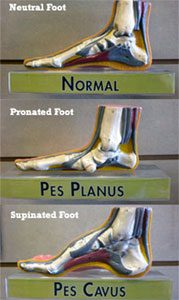 Normal Foot
Normal Foot
It is a foot said to be neutral in supination and pronation at the subtaler joint. When the Wet Foot Test is performed the C-curve tends to be in between high and low with good demarcation to the left. A neutral foot allows for neutral pronation and is the most idea foot type as it will allow for the most efficient type of gait.
Flat Foot
A flat foot is said to be pronated at the subtaler joint without a C-curve print on Wet Foot Test also called Pes Planus. A pronated foot usually results in the arches falling when the ankle rolls inward through the loading phase in gait.
High Arch Foot
A high arched foot is said to be supinated at the subtaler joint with a prominent C-curve print on Wet Foot Test also termed Pes Cavus. A supinated foot, on the other hand, will not roll far enough inwards through the loading phase which results in limited motion at the arches through the gait cycle.
Aside from the foot type, there are other deformity which are important considerations when selecting a shoe i.e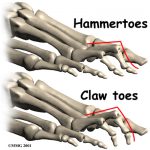 Claw Toes or Hammer Toes. A claw toe is when both middle joint proximal interphalangeal joint and the small joint at the end of the toe (distal interphalengeal joint) are curved downwards like a claw. A hammer toe is when the first joint proximal interphalangeal joint is cocked upwards and the middle joint proximal interphalangeal joint is bent forward.
Claw Toes or Hammer Toes. A claw toe is when both middle joint proximal interphalangeal joint and the small joint at the end of the toe (distal interphalengeal joint) are curved downwards like a claw. A hammer toe is when the first joint proximal interphalangeal joint is cocked upwards and the middle joint proximal interphalangeal joint is bent forward.
After getting acquainted to the foot type one has, then it is vital to have knowledge of the structural make up of a shoe as follows:
The Shoe Last
The fit of a shoe depends on the design, shape and volume of the shoe last. The shoe last must represent the anatomical information of the foot, at the same time giving the finished shoe a pleasing and fashionable appearance. It is designed for a particular heel height, toe shape, specific stress points during movement and type of footwear. If you remove the insole of your shoe you should be able to see the last of the shoe construction.
- A shoe constructed with a cardboard last is more stable and more suitable for
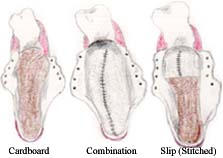 individuals with flat feet.
individuals with flat feet. - A shoe constructed with a combination last has cardboard in the rear half and a stitched seam in the front half which allows it to be more flexible than a cardboard last and more stable than a slip last.
- A shoe constructed with a slip last has a stitched seam which is less stable and more suitable for individuals with high arches
Inspecting and examining the shape of the last informs of what kind of foot type can be well accommodated by the shoe such that:
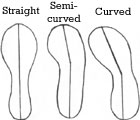 A straight last is recommended for individuals who have flat feet or have a tendency to over pronate.
A straight last is recommended for individuals who have flat feet or have a tendency to over pronate.- A semi-curved last is recommended for individuals with normal arches.
- A curved last is recommended for individuals who have high arches or have a tendency to over supinate.
Upper Show Contruct
The upper is the top part of the shoe and is composed of the toe box, vamp, 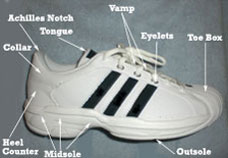 tongue, laces and heel counter. The toe box and vamp provide protection to the forefoot and toes. If the toe box is small this can result in irritation or injury to the toes and nails. The tongue and laces assist with proper fit and upper foot cushioning while the heel counter plays a key role with stabilization of the rear foot. The heel counter can be constructed with chemical sheets or thermoplastic. Heel counters which are constructed with thermoplastics are more firm and will be able to provide more support.
tongue, laces and heel counter. The toe box and vamp provide protection to the forefoot and toes. If the toe box is small this can result in irritation or injury to the toes and nails. The tongue and laces assist with proper fit and upper foot cushioning while the heel counter plays a key role with stabilization of the rear foot. The heel counter can be constructed with chemical sheets or thermoplastic. Heel counters which are constructed with thermoplastics are more firm and will be able to provide more support.
Midlesole Show Construct
Midsole is an area where technological advancement by manufacturer’s focus at for research and development on. Majority utilize ethylene vinyl acetate (EVA), polyurethane or a combination of both. EVA is a light material which can be compressed but ages and wears out rapidly. Polyurethane, on the other hand, is a denser and more durable material which lasts longer. Many shoe manufactures are utilizing a multi-density midsole consisting of a softer material for the lateral side to soften impact and a firm medial side for support.
Having inappropriate footwear predisposes you to have poor foot posture and increases the chances of lower limb injuries such as:
- Achilles tendonitis
- Planter fasciitis
- Patellofemoral Syndrome
- Stress fracture
- Shin splints (Medial Tibial Stress Syndrome)
- ITB friction syndrome (Pes Planus)
- Patella tendonitis
A focus beyond the artistic appearance of a shoe should consider shoe appropriate for an individual for preventive and specific rehabilitative needs. There for it is important to make sure shoes:
- are long enough to allow room for longer toes
- should have wide toe boxes for toe movements
- should have soft insoles to absorb pressure.
- outsole should facilitate appropriate friction reaction force for movement
- anterior space should not be compressive during movement.
All said don’t forget that our foot are made up of muscles that require to be stretched or strengthened, joints to be mobilized and providing support either in form of orthotic insole to correction of foot biomechanics such that we also prevent acquired flat foot due to lifestyle, that’s then when our shoe becomes the heart print of our foot in health.